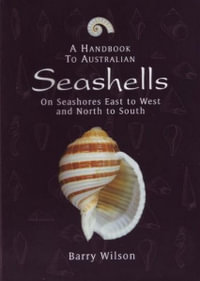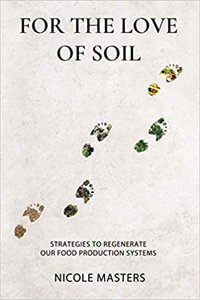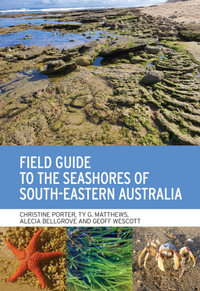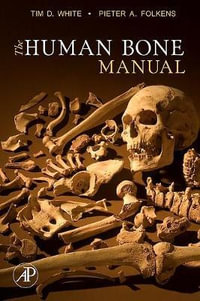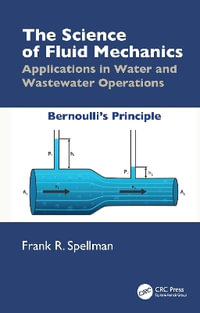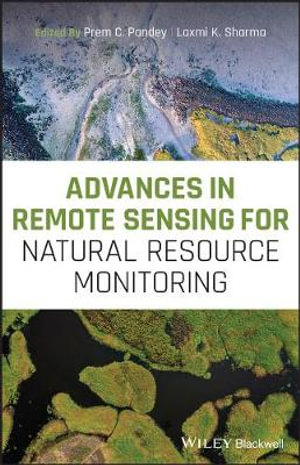
Advances in Remote Sensing for Natural Resource Monitoring
By: Prem C. Pandey (Editor), Laxmi K. Sharma (Editor)
Hardcover | 21 January 2021 | Edition Number 1
At a Glance
528 Pages
229.0 x 152.0 x 3.09
Hardcover
RRP $379.45
$313.25
17%OFF
or 4 interest-free payments of $78.31 with
orAims to ship in 7 to 10 business days
Sustainable management of natural resources is an urgent need, given the changing climatic conditions of Earth systems. The ability to monitor natural resources precisely and accurately is increasingly important. New and advanced remote sensing tools and techniques are continually being developed to monitor and manage natural resources in an effective way. Remote sensing technology uses electromagnetic sensors to record, measure and monitor even small variations in natural resources. The addition of new remote sensing datasets, processing techniques and software makes remote sensing an exact and cost-effective tool and technology for natural resource monitoring and management.
Advances in Remote Sensing for Natural Resources Monitoring provides a detailed overview of the potential applications of advanced satellite data in natural resource monitoring. The book determines how environmental and - ecological knowledge and satellite-based information can be effectively combined to address a wide array of current natural resource management needs. Each chapter covers different aspects of remote sensing approach to monitor the natural resources effectively, to provide a platform for decision and policy. This important work:
- Provides comprehensive coverage of advances and applications of remote sensing in natural resources monitoring
- Includes new and emerging approaches for resource monitoring with case studies
- Covers different aspects of forest, water, soil- land resources, and agriculture
- Provides exemplary illustration of themes such as glaciers, surface runoff, ground water potential and soil moisture content with temporal analysis
- Covers blue carbon, seawater intrusion, playa wetlands, and wetland inundation with case studies
- Showcases disaster studies such as floods, tsunami, showing where remote sensing technologies have been used
This edited book is the first volume of the book series Advances in Remote Sensing for Earth Observation.
List of Abbreviations xix
List of Contributors xxix
List of Editors xxxv
Preface xxxvii
Section I General Section 1
1 Introduction to Natural Resource Monitoring Using Remote Sensing Technology 3
Prem Chandra Pandey and Laxmi Kant Sharma
1.1 Introduction 3
References 6
2 Spectroradiometry: Types, Data Collection, and Processing 9
Prem Chandra Pandey, Manish Kumar Pandey, Ayushi Gupta, Prachi Singh, and Prashant K. Srivastava
2.1 Introduction 9
2.2 Literature Review 10
2.3 The Types of Spectroradiometry 12
2.3.1 Spectroradiometry 13
2.3.2 Photometry and Colorimetry 13
2.4 Principle of the Spectroradiometer 13
2.5 Radiance Measurement 16
2.5.1 Factors Affecting Spectral Reflectance Measurements 17
2.5.2 Data Processing 18
2.5.2.1 Radiometric Calibration 18
2.5.2.2 Reflectance/Transmittance 19
2.5.2.3 Radiance/Irradiance/Emissivity 20
2.5.2.4 1st Derivative 20
2.5.2.5 2nd Derivative 20
2.5.2.6 Parabolic Correction 20
2.5.2.7 Other Methods 21
2.6 Data Collection 21
2.7 Generation of the Metadata 21
2.7.1 Continuum Removal 22
2.8 Applications of ASD in Agriculture and Forestry 23
2.9 Future Importance, Limitations, and Recommendations 23
Acknowledgment 24
References 24
3 Geometric-Optical Modeling of Bidirectional Reflectance Distribution Function for Trees and Forest Stands 28
Nour El Islam Bachari, Salim Lamine, and Khaled Meharrar
3.1 Introduction 28
3.2 Model Description 29
3.2.1 Sunlit Surfaces 31
3.2.2 Shaded Surfaces 31
3.2.3 Forest Stand Modeling 32
3.3 General Shape of the Apparent Luminance 33
3.4 Simulation and Discussion 35
References 39
Section II Vegetation Resource Monitoring (Forest and Agriculture) 43
4 Mapping Stand Age of Indonesian Rubber Plantation Using Fully Polarimetric L-Band Synthetic Aperture Radar 45
Bambang H. Trisasongko
4.1 Introduction 45
4.2 Methodology 46
4.2.1 Test Site and Dataset 46
4.2.2 Processing 47
4.3 Results and Discussion 48
4.3.1 Scattering Behavior 48
4.3.2 Classification Using Backscatter Coefficients 50
4.3.3 Classification Using Model-Based Decomposition 51
4.3.4 The Role of Combining Datasets 51
4.3.5 The Best Subset 52
4.4 Conclusion 55
Acknowledgments 55
References 55
5 Responses of Multi-Frequency Remote Sensing to Forest Biomass 58
Suman Sinha, A. Santra, Laxmi Kant Sharma, Anup Kumar Das, C. Jeganathan, Shiv Mohan, S.S. Mitra, and M.S. Nathawat
5.1 Background 58
5.1.1 Optical Remote Sensing 59
5.1.2 Microwave Remote Sensing 62
5.1.3 LiDAR Remote/Sensing 63
5.1.4 Synergic Use of Multi-Sensor Data 65
5.2 A Case Study in the Mixed Tropical Deciduous Forest of India 66
5.2.1 Study Area 66
5.2.2 Datasets 67
5.2.3 Methodology 67
5.2.4 Results 67
5.2.5 Conclusion 67
5.3 Uncertainties and Future Scope of Research in Biomass Estimation 71
5.3.1 Summary 71
Acknowledgment 72
References 72
6 Crop Water Requirements Analysis Using Geoinformatics Techniques in the Water-Scarce Semi-Arid Watershed 81
K. Ibrahim-Bathis, S.A. Ahmed, V. Nischitha, and M.A. Mohammed-Aslam
6.1 Introduction 81
6.1.1 Crop Calendar 82
6.1.2 Crop Type Classification 83
6.1.3 Crop Water Requirements 86
6.1.4 CROPWAT Model 86
6.1.5 Meteorological Data 86
6.2 Reference Evapotranspiration (ETo) 86
6.2.1 Effective Rainfall 88
6.2.2 Crop Coefficient (Kc) 89
6.3 Soil Data 89
6.4 Crop Evapotranspiration (ETc) 90
6.5 Irrigation Water Requirement 90
6.6 Conclusion 91
Acknowledgment 92
References 92
7 Biophysical Characterization and Monitoring Large-Scale Water and Vegetation Anomalies by Remote Sensing in the Agricultural Growing Areas of the Brazilian Semi-Arid Region 94
Antonio Heriberto de Castro Teixeira, Janice Freitas Leivas, Edson Patto Pacheco, Edlene Aparecida Monteiro Garçon, and Celina Maki Takemura
7.1 Introduction 94
7.2 Material and Methods 96
7.3 Results and Discussion 99
7.4 Conclusions 104
Acknowledgments 105
References 105
Section III Soil and Land Resource Monitoring 111
8 SMOS L4 Downscaled Soil Moisture Product Evaluation Over a Two Year – Period in a Mediterranean Setting 113
Patrick N.L. Lamptey, George P. Petropoulos, and Prashant K. Srivastava
8.1 Introduction 113
8.2 Experimental Setup 116
8.3 Datasets Description 116
8.3.1 SMOS L4 SM Product (1 km) 116
8.3.2 In-situ Soil Moisture Data 118
8.4 Methodology 119
8.4.1 SSM Extraction from SMOS 119
8.4.2 Pre-Processing of SMOS 119
8.4.3 Agreement Evaluation 119
8.5 Results 120
8.5.1 Station ES-CPA 120
8.5.2 Station N9 122
8.5.3 Station M5 123
8.5.4 Station H7 123
8.5.5 Station K9 124
8.6 Discussion 126
8.7 Conclusions 127
Acknowledgments 128
References 128
9 Estimating Urban Population Density Using Remotely Sensed Imagery Products 132
Dimitris Triantakonstantis, Demetris Stathakis, and Zoi Papadopoulou
9.1 Introduction 132
9.2 Spatial Data Disaggregation–MAUP Problem 134
9.2.1 Spatial Interpolation 135
9.3 Materials and Methods 136
9.3.1 Study Area and Data Sources 136
9.3.2 Areal Interpolation Using Cokriging 137
9.4 Areal Interpolation Using Geographically Weighted Regression (GWR) 138
9.5 Results and Discussion 139
9.6 Conclusions 144
References 145
10 Impact of Land Cover Change on Surface Runoff 150
Apoorv Sood, S.K. Ghosh, and Priyadarshi Upadhyay
10.1 Introduction 150
10.2 Literature 151
10.3 Methodology 152
10.3.1 Supervised Classification 152
10.3.2 SWAT Model 153
10.3.3 SWAT Inputs 153
10.3.4 SWAT Outputs 154
10.4 Methodology 154
10.5 Study Area 154
10.5.1 Justification for Study Area Selection 154
10.6 Data Used 155
10.6.1 Weather Data 156
10.6.2 Satellite Data 158
10.6.2.1 LANDSAT Dataset 158
10.6.3 Digital Elevation Model 158
10.6.4 Soil Map 158
10.7 Results and Discussion 158
10.7.1 LU/LC Classification 158
10.7.2 LU/LC Map 1987 161
10.7.3 LU/LC Map 1997 161
10.7.4 LU/LC Map 2007 161
10.7.5 LU/LC Map 2017 161
10.7.6 Watershed Delineation 163
10.8 SWAT Results 164
10.8.1 HRU Analysis Report 164
10.8.2 Runoff Generated in Sub Basins 164
10.9 Conclusion 167
Acknowledgment 168
References 168
11 Delineation of Groundwater Potential Zone and Site Suitability of Rainwater Harvesting Structures Using Remote Sensing and In Situ Geophysical Measurements 170
Prachi Singh, Akash Anand, Prashant K. Srivastava, Arjun Singh, and Prem Chandra Pandey
11.1 Introduction 170
11.2 Study Area 171
11.3 Data Used and Methodology 172
11.3.1 Data Used 172
11.3.2 Methodology 173
11.3.3 Vertical Electrical Sounding 173
11.3.4 Weightage Calculation 174
11.4 Results and Discussion 175
11.4.1 Land Use and Land Cover (LULC) 175
11.4.2 Soil 175
11.4.3 Hydro-Geomorphology 176
11.4.4 Lithology 176
11.4.5 Drainage Density 178
11.4.6 Lineament Density 178
11.5 Resistivity Survey 179
11.5.1 VES Survey and Cross Section 179
11.5.2 Interpolated Subsurface Soil Profile 181
11.5.3 Groundwater Potential Zone 181
11.5.4 Suitable Sites for Rainwater Harvesting Structures 182
11.6 Conclusions 185
Acknowledgment 186
References 186
12 Structural Control on the Landscape Evolution of Son Alluvial Fan System in Ganga Foreland Basin 189
Manish Pandey, Yogesh Ray, Aman Arora, U.K. Shukla, and Shyam Ranjan
12.1 Introduction 189
12.2 Study Area 192
12.2.1 Geomorphological Setting of SAFS 192
12.2.2 Geology of the Son Valley and SAFS 196
12.2.3 Drainage 196
12.2.4 Climate 197
12.3 Materials and Methods 198
12.3.1 Data Used 198
12.3.2 Preprocessing of DEM 199
12.3.3 DEM Derived Parameters 199
12.3.4 Conceptual Background 199
12.3.4.1 Quantitative Measure of River Basin Dynamics/Reorganization 200
12.3.4.2 X (χ)-Metrics and Cross-Divide χ-Anomaly 200
12.3.4.3 Rationale Behind Experimental Use of χ-Transform for Alluvial Stream Long Profiles 203
12.3.5 Normalized Channel Steepness Index (ksn) and Channel Concavity Index (θ) Computation 205
12.3.6 Stream Sinuosity 205
12.3.7 Hypsometric Curve (HC) 206
12.4 Results and Discussion 206
12.4.1 Zones of (dis)equilibrium Over SAFS in Ganga Foreland Basin (GFB) 206
12.4.2 Sinuosity of Streams and Drainage Behavior Over SAFS 211
12.4.3 Extent of SAFS vis-a-vis Evolution of Ganga Plain 212
12.5 Conclusion and Recommendations 214
Acknowledgments 215
References 215
12.A Appendix A: Supplementary Figures 226
12.B Field Evidences of Neotectonic Activity (Source: Google Earth Pro) 240
12.C Longitudinal Profile of the Ganga and its Right Bank Tributaries Flowing over SAFS 242
12.D Lines of Cross-Sectional and Longitudinal Profiles 244
12.E SAFS Profiles from Pandey 2014 245
Section IV Water Resource Monitoring 247
13 Managing the Blue Carbon Ecosystem: A Remote Sensing and GIS Approach 249
Parul Maurya, Anup Kumar Das, and Rina Kumari
13.1 Introduction 249
13.2 Blue Carbon Ecosystem 249
13.2.1 Distribution 250
13.2.2 Mangrove 251
13.2.3 Seagrass 251
13.2.4 Salt Marshes 252
13.3 Factors Affecting Carbon Storage in Blue Carbon Ecosystems 253
13.4 Carbon Storage in the Blue Carbon Ecosystem 254
13.5 Pathways of Carbon in the Blue Carbon Ecosystem 254
13.6 Evaluation of Long-Term Carbon Deposition in Sediments 255
13.7 Ecosystem Services 256
13.8 Threats to Coastal Blue Carbon Ecosystems 256
13.9 Economy of Blue Carbon Ecosystems 257
13.10 Management 258
13.11 Conservation of Blue Carbon Ecosystem: A Remote Sensing Approach 258
13.11.1 Role of Optical Remote Sensing 259
13.11.2 Mapping the Mangrove Cover and Change Detection 259
13.12 Quantification of Biophysical Variables 260
13.12.1 Phenology 260
13.12.2 Role of Hyperspectral Remote Sensing 260
13.12.3 Mangrove-Mapping and Dynamics Studies Using Radar Data 261
13.12.4 Dependence on Frequency 261
13.12.5 Species Identification 261
13.13 Conclusion 262
Acknowledgment 262
References 262
14 Appraising the Changing Climate and Extent of Snow in the Kashmir Himalaya Using MODIS Data 269
Seema Rani
14.1 Introduction 269
14.2 Study Area 270
14.3 Materials and Methods 271
14.4 Results and Discussions 273
14.4.1 Trend in Air Temperature 273
14.4.2 Trend in Snow Cover Area 275
14.4.3 Variations in SCA Under Elevation Zones 278
14.5 Conclusion 282
Acknowledgments 283
References 283
15 Knowledge-Based Mapping of Debris-Covered Glaciers in the Greater Himalayan Range 287
Swagata Ghosh and Raaj Ramsankaran
15.1 Introduction 287
15.1.1 Overview of Ablation Pattern of Glaciers in the Western Himalaya 288
15.1.2 Overview of Glacier Mapping Techniques 288
15.2 Study Area 290
15.3 Data Sources 291
15.4 Methodology 292
15.4.1 Pre-Processing of Satellite Data 293
15.4.2 Knowledge-Based Approach 295
15.4.2.1 Segregation of Snow and Ice from Other Land Covers Using Spectral Index 295
15.4.2.2 Segregation Between Snow and Ice Types Using Spectral Indices 298
15.4.2.3 Segregation of Supraglacial Debris Types from Non-Glacier Area 298
15.5 Results and Discussions 299
15.5.1 Accuracy Assessment of Supraglacial Covers Mapping of Pensilungpa Glacier 303
15.5.2 Knowledge-Based Approach Versus Manual Digitization for Mapping Pensilungpa Glacier 304
15.5.3 Uncertainty Analysis 306
15.5.4 Knowledge-Based Approach Versus Supervised Classification for Mapping Pensilungpa Glacier 307
15.5.5 Evaluation of Spatiotemporal Application Potential of the Knowledge-Based Approach 311
15.6 Summary and Conclusions 312
15.7 Future Scope 315
References 315
16 Seawater Intrusion and Salinity Mapping in Coastal Aquifers: A Geospatial Approach 323
Tanushree and Rina Kumari
16.1 Introduction 323
16.1.1 Water Stress in Coastal Aquifers Due to Salinity: A Global Concern 323
16.1.2 Salinization of Aquifers in Semiarid Regions 324
16.1.3 Seawater Intrusion: Basic Concept 324
16.1.4 Various Approaches to Study Seawater Intrusion 325
16.2 Aquifer Vulnerability Concept 326
16.2.1 Vulnerability Types 327
16.2.1.1 Intrinsic Vulnerability 327
16.2.1.2 Specific Vulnerability 327
16.2.2 Aquifer Vulnerability Due to Seawater Intrusion 327
16.2.3 Methods to Assess Vulnerability 327
16.2.3.1 Sensitivity Analysis 328
16.2.4 Significance 331
16.2.5 Geophysical Approaches 332
16.2.5.1 Electromagnetic Surveys 332
16.2.5.2 Time Domain Electromagnetic (TDEM) 333
16.2.5.3 Frequency Domain Electromagnetic (FEM) 333
16.2.5.4 Self-Potential 333
16.2.5.5 Ground Penetrating Radar 333
16.2.6 Numerical Model for Explaining Seawater Intrusion 334
16.2.7 Remote Sensing for Salinity Mapping 334
16.2.7.1 Optical Remote Sensing for Salinity Mapping 334
16.2.7.2 Hyperspectral Remote Sensing 335
16.2.7.3 Microwave Remote Sensing for Salinity Mapping 335
16.3 Conclusion 336
Acknowledgments 337
References 337
17 Wetland-Inundated Area Modeling and Monitoring Using Supervised and Machine Learning Classifiers 346
Swapan Talukdar, Sakshi Mankotia, Md Shamimuzzaman, Shahfahad, and Susanta Mahato
17.1 Introduction 346
17.2 Study Area 348
17.3 Data Sources and Methods 349
17.3.1 Data Sources 349
17.3.2 Methods for Wetland-Inundated Area Mapping 349
17.3.2.1 Methods for Machine Learning Classifiers 350
17.3.2.2 Method for Supervised Classifiers 352
17.3.3 Methods for Accuracy Assessment of Wetland-Inundation Area Mapping 352
17.3.4 Methods of Modeling Wetland Landscape Transformation 353
17.4 Results and Discussion 353
17.4.1 Wetland Mapping Using Different Classifiers 353
17.4.2 Validation of the Methods 354
17.4.3 Spatiotemporal Analysis of Hydrological Variability of the Wetlands 356
17.4.4 Fragmentation Analysis of the Hydrological Variability 357
17.5 Conclusion 360
Acknowledgment 360
References 360
18 A Focus on Reaggregation of Playa Wetland scapes in the Face of Global Ecological Disconnectivity 366
Laxmi Kant Sharma, Rajashree Naik, and Prem Chandra Pandey
18.1 Introduction 366
18.2 Global Ecological Disconnectivity 367
18.3 Playa Wetland scapes 367
18.3.1 Importance 368
18.3.2 Threats 368
18.3.3 Playas of India 370
18.4 Indian Playa Wetland scapes for Global Ecological Connectivity 371
18.5 Reaggregation of Playa Wetland scapes 374
18.6 Recent Approaches Used for Wetland scape Studies 375
18.7 Limitations of Current Wetland scape Studies 377
18.8 Scope of Integrated Playa Wetland scape Modeling 380
Acknowledgment 381
References 381
Section V Disaster Monitoring of Natural Resources 389
19 Flood Damage Assessment in a Part of the Ganga-Brahmaputra Plain Region, India 391
Rajesh Kumar
19.1 Introduction 391
19.2 Study Area 393
19.3 Materials and Methods 393
19.4 Results and Discussion 395
19.4.1 Flood-Prone and Flooded Areas 395
19.4.2 Flood Damage and Flood Protection Works 396
19.4.3 Trends in Flood Damage and Peak Flood Discharge 398
19.5 Conclusions 400
Acknowledgments 401
Declaration 401
References 401
20 Texture-Based Riverine Feature Extraction and Flood Mapping Using Satellite Images 405
Kuldeep, P.K. Garg, and R.D. Garg
20.1 Introduction 405
20.2 Related Work 406
20.3 The Study Area and Data Resources 408
20.4 Methodology 408
20.4.1 Geometric Correction and Image Enhancement 408
20.4.2 Texture Feature Extraction and Optimal Feature Selection 409
20.4.3 Texture-Based Classification 411
20.4.4 Flood Hazard Mapping for Identification of Safe Islands 411
20.4.4.1 Flood Inundation Mapping 411
20.4.4.2 Validation of Flood Extent 412
20.4.4.3 Damage Assessment 412
20.5 Results and Discussions 413
20.5.1 Feature Selection and Classification 413
20.5.2 Flood Hazard Mapping 418
20.5.3 HEC-RAS Processing and Model Validation 419
20.5.4 Flood Damage Assessment 421
20.6 Conclusion 424
Acknowledgment 426
References 426
21 Numerical Simulation and Comparison of Tsunami Inundation for Different Satellite-Derived Datasets for the Gujarat Coast of India 431
Shafique Matin and S.S. Praveen
21.1 Introduction 431
21.2 Study Area 432
21.3 Methodology 432
21.3.1 Extraction of Different Satellite-Derived Datasets 432
21.3.2 Numerical Modeling 434
21.4 Results and Discussion 436
21.4.1 Analysis of Datasets 439
21.4.2 Parallel Transects 440
21.4.3 Perpendicular Transects 440
21.5 Conclusions 442
Acknowledgments 442
References 443
Section VI Future Aspect of Natural Resource Monitoring 445
22 Future Aspects and Potential of the Remote Sensing Technology to Meet the Natural Resource Needs 447
Laxmi Kant Sharma, Rajit Gupta, and Prem Chandra Pandey
22.1 Introduction 447
22.2 Advances in Remote Sensing for Natural Resources Monitoring 449
22.3 Potential Applications in Natural Resource Monitoring 451
22.4 Challenges and Future Aspects 453
22.5 Conclusion 455
Acknowledgment 456
References 456
Index 465
ISBN: 9781119615972
ISBN-10: 1119615976
Published: 21st January 2021
Format: Hardcover
Language: English
Number of Pages: 528
Audience: Professional and Scholarly
Publisher: John Wiley & Sons (UK)
Country of Publication: GB
Edition Number: 1
Dimensions (cm): 229.0 x 152.0 x 3.09
Weight (kg): 1.14
Shipping
| Standard Shipping | Express Shipping | |
|---|---|---|
| Metro postcodes: | $9.99 | $14.95 |
| Regional postcodes: | $9.99 | $14.95 |
| Rural postcodes: | $9.99 | $14.95 |
How to return your order
At Booktopia, we offer hassle-free returns in accordance with our returns policy. If you wish to return an item, please get in touch with Booktopia Customer Care.
Additional postage charges may be applicable.
Defective items
If there is a problem with any of the items received for your order then the Booktopia Customer Care team is ready to assist you.
For more info please visit our Help Centre.

